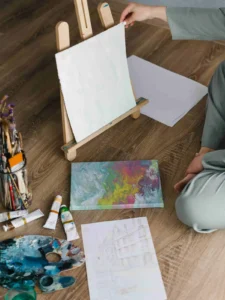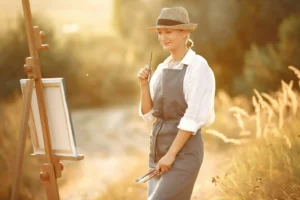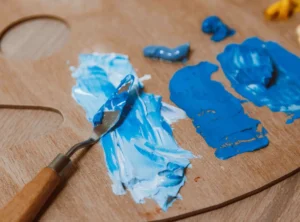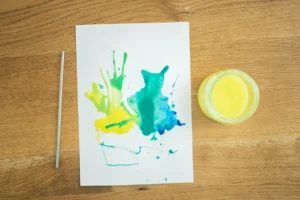Diving into the world of acrylic painting can be incredibly rewarding – and so much fun! It’s a medium that offers endless creativity, but let’s face it, beginners can trip over the same hurdles.
Don’t worry, though! Here are some common mistakes to dodge, so you can keep your painting journey fun and fruitful!
1. Lack of Planning
A major rookie mistake when painting is diving in without a proper plan.
It’s tempting to grab a brush and start slapping on paint, but without a game plan, things can quickly go sideways. You might end up with mismatched colors, uneven coats, or messy edges that make the whole painting look amateurish, or worse, poor placement of elements that throw off the composition. You might even run out of space or end up with proportions that look wonky and unbalanced.

Take some time to map out your painting: pick your colors, gather your supplies, prepare your surfaces and figure out the order of tasks.
Sketching out your composition beforehand ensures everything fits nicely and looks harmonious. You don’t have to go into great detail in your sketch – just enough to give you an idea of where everything will be be.
This way, you’ll save yourself from the frustration of unexpected hiccups and ensure a smoother, more polished finish.
Planning might seem like a drag, but it pays off big time when you see the end result.
2. Forgetting About Composition
When you look at a painting that captivates you, it’s not just the colors or the subject that draw you in—it’s the composition.
Composition is the strategic arrangement of elements within a painting, guiding the viewer’s eye and creating a sense of harmony and balance. It’s the unsung hero behind every great artwork, transforming a simple canvas into a compelling visual journey.
For beginners in acrylic painting, mastering composition is key to creating pieces that are not only beautiful but also impactful. Without a solid composition, even the most vibrant colors and intricate details can fall flat, leaving your artwork feeling disjointed and unpolished. Check out this article on more about composition.
3. Not Mixing Enough Paint
We’ve all been there. You’re in the zone, your brush is gliding across the canvas, and then—bam! You run out of that perfect shade you just mixed. Cue the frustration. Not mixing enough paint is a classic rookie mistake, but it’s totally avoidable. Just make sure you mix enough paint to cover the areas you plan to work on.

It’s better to mix a little more than you think you’ll need than to run out mid-painting.
4. Ignoring Drying Time
Ah, the speedy drying time of acrylic paint—it’s like a double-edged sword, right? One minute, it’s your best friend, helping you layer up quickly; the next, it’s your worst enemy, leaving you with a hot mess if you’re not careful.
A classic blunder is painting over layers that aren’t fully dry yet (unless you want to blend the colors on your canvas – which you have to be extra intentional in doing and can be tricky if you’re just starting out).
The result? Muddy colors and textures you definitely didn’t ask for. Patience is your new BFF here. Let those layers dry completely before moving on to the next. Trust me, your masterpiece will thank you!
5. Overworking the Paint
It’s easy to get carried away and keep adding more and more paint to a section of your painting. But beware! Overworking your painting can turn those vibrant colors into a muddy mess.
Remember, sometimes less is more! Knowing when to step back and call it done is key. Give your painting a chance to shine without piling on too much.
Trust your instincts and know when to say, “That’s a wrap!”
6. Using Too Much Water – Or too little
Finding the Goldilocks zone with water is a must! Too much water and your acrylics turn into a drippy, diluted mess; too little and they’re thick, hard to spread, and can crack.
Aim for that sweet spot where your paint is just right—smooth, creamy, spreading easily across the canvas. If you’re struggling, try using a spray bottle to lightly mist your palette and keep your paint workable without turning it into a puddle.

Finding that sweet spot takes a bit of practice, but once you do, your paintings will thank you!
7. Rushing Through the Painting
Take your time. Rushing can lead to sloppy work and missed details. Enjoy the process and give each layer the attention it deserves.
Sometimes stepping back and taking a break can give you a fresh perspective and help you see what your painting needs next.

8. Neglecting to Mix Colors
Using paint straight from the tube can make your artwork look, well, kinda blah.
Mix your colors! It adds depth and dimension to your paintings. Don’t be afraid to experiment. Sometimes, the best colors come from unexpected combinations.

9. Sticking to the Same Techniques
When you’ve got a few paintings in your budding collection, you’d have developed a few techniques that you’re now tempted to stick with —you’re familiar with them, and they’re comfy like an old pair of jeans! But doing so can put a serious lid on your artistic adventure.
Try learning new things and mixing it up and taking your skill just a tiny step further. Don’t be afraid to dive into new techniques, styles, and color combos.
Experimenting can lead to awesome discoveries and help you find your own unique artistic groove.
10. Neglecting Brush Care
Alright, here’s the scoop: acrylic paint dries faster than you can say “oops,” and if you don’t clean your brushes right away, they’ll turn into a sad, crusty mess.
Give them a good rinse with water as soon as you’re done painting. Your future self will thank you for those clean, happy brushes! For more tips on how to take care of your brushes – check out this article.
11. Being Afraid to Make Mistakes
Hey, don’t sweat those blunders—embrace them! Mistakes are actually your best pals on the learning journey.

Feel free to experiment with new techniques and color combos; some of the coolest discoveries come from those happy accidents.
And if you do mess up, just let it dry and paint right over it. Acrylics are super forgiving, so you can easily fix or change anything as you go. So go ahead, make those mistakes and watch your skills skyrocket!
12. Comparing Yourself to Others
It’s super easy and natural to get caught up in comparing your work to other artists’, but trust me, it is a total joy-killer.
Everyone’s on their own artistic journey, moving at their own speed, and that’s what makes each path unique.
Instead of looking sideways, turn your gaze inward and appreciate how far you’ve come. Celebrate the small victories and improvements and give yourself a high-five for each milestone you hit.
Remember, even the art legends you so admire were once beginners, figuring things out just like you. So, embrace your journey and keep painting your heart out—your unique style is what makes your art special!
13. Not Having Fun
Last but not least, don’t forget to have fun. Painting should be an enjoyable and relaxing activity.

Don’t get so caught up in the technicalities that you forget why you started painting in the first place. Enjoy the colors, the process, and the creativity.
Starting out with acrylic painting can be a bit daunting, but dodging these common mistakes can make your art journey way smoother and a lot more fun. Take your time, play around with new techniques, experiment, and enjoy the process. Happy painting!
